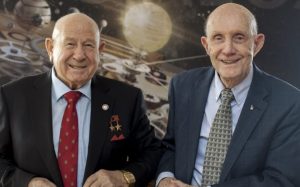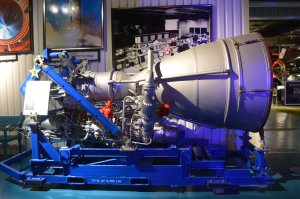
The Stafford Air and Space Museum in Weatherford has bragging rights about its latest acquisitions.
The museum named for Astronaut Thomas P. Stafford has been given temporary use of personal items including a space suit of Russian cosmonaut Alexei Leonov who died last month, but only after developing a brother-like friendship with Stafford.
Part of his legacy remains through his own personal artifacts on display at the Stafford Air and Space Museum. Leonov – twice decorated with his country’s top honor, the Hero of the Soviet Union – was the first human to walk in space. The highly accomplished cosmonaut commanded the Soviet side of the Apollo-Soyuz mission, which was the final flight for the Apollo program, and the first spaceflight in which spacecrafts from different nations docked in space.
The United States and the Soviet Union were bitter rivals during the space race years that preceded the Apollo-Soyuz mission. Leonov and Stafford, the Apollo’s commander, became close friends as they prepared for the mission.
The Soviet Cosmonaut and Western Oklahoma boy had a special bond from the very beginning. Their friendship turned the unlikely duo into lifelong friends; both becoming more like brothers. Alexei visited the Stafford Museum on several occasions, and many community members had the privilege of meeting the diplomat.
Leonov honored his friendship with Stafford by donating a handful of significant personal items over the years to the museum, including his actual military uniform.
 |
Alexei Leonov’s military uniform
In the Apollo-Soyuz gallery, a life-size mannequin of Major General Alexei Leonov stands dressed in his actual flown cosmonaut in-flight garment that he wore during the Apollo-Soyuz mission. The museum’s gallery also contains many other Russian treasures, including a triple barrel gun that Leonov gave to Stafford. The same type of gun was carried aboard the Soviet spacecraft as part of their survival kits.
An NK-33 rocket engine is the museum’s most recent Russian collection acquisition. The NK-33 was the highest performing liquid oxygen/kerosene engine ever built. It was designed to power the giant N-1 moon rocket – the Soviet competitor to the American Saturn V rocket, according to the news release.
 |
NK-33Rocket Engine.
The Stafford Air and Space Museum is the only facility in the world to have the main propulsion engines from both the Soviet and U.S. moon rockets.
The museum’s connection to the Russian space program will continue beyond Leonov’s death.
The museum will continue to share the story of the two unlikely comrades that aided in one of the most significant collaborations in history, showing that cooperation between countries of diverse nature could work, and that nations could come together for the greater good, forever impacting the future of spaceflight.
The Stafford Air and Space Museum is one of only three Smithsonian Affiliate museums in Oklahoma. For more information go to staffordmuseum.org.
The museum is open seven days a week.
Source: Stafford Air and Space Museum






